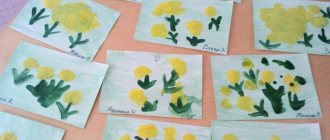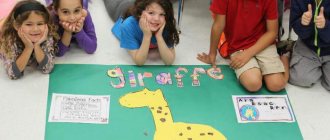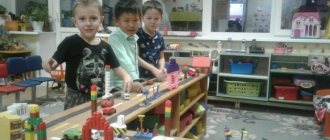Card index of didactic drawing games for children of senior preschool age
Card index of didactic drawing games for children of senior preschool age.
1. Games that promote the development of compositional skills, starting from the uniform arrangement of objects on a sheet of paper in drawing and appliqué with a conscious combination of objects in shape, color and size.
1. "Artists" / "Perspective"
Goal: to develop children’s initial compositional skills.
Game task: “draw a picture” (place the proposed pictures on the “lawn”); option: place the pictures in a specific place at the teacher’s suggestion.
2. “Collect a landscape and still life”
“By the example of landscape and still life it is convenient to develop a sense of composition”
Purpose of the game: to develop compositional thinking skills, consolidate knowledge of the concepts of “landscape” and “still life”, develop observation and memory.
Progress of the game: the child is asked to create a landscape and a still life from a set of pictures, select objects, and build the correct composition.
3. “Imagine a landscape”
3-6 children can take part in the game.
Purpose of the game: to train children in composing a composition with multifaceted content, highlighting the main size. Exercise children in composing a composition united by a single content. To consolidate children's knowledge about seasonal changes in nature. Clarifying children's knowledge about landscape as a form of painting. Develop children's observation skills and creative imagination.
Progress of the game: the child is asked to create a landscape of a certain season - winter, spring, autumn or winter - from a set of pictures; the child must build the correct composition corresponding to this particular time of year.
2. Games that promote the development of graphic skills and understanding of the design features of the form
By playing these games, children develop spatial imagination and learn to recognize an object by its individual properties and parts.
For example: “Assemble a figure from a picture”, “Shapes”, “What does it look like”, “Recognize an object by its silhouette”.
1. ASSEMBLE THE FIGURE FROM THE PICTURE
The teacher tells the children that they will collect different figures. Shows one of the pictures, for example a dog, and offers to assemble the same dog from parts. Children create the proposed image and check whether it matches the given pattern. Then you can offer another picture or give all the diagrams to the children so that they collect the shapes and exchange parts.
A complication of the game can be assembling a figure from memory or replacing one part with another that is suitable in a given case, or inventing your own animal from the proposed parts.
2. Didactic game “What is it like?”
Goal: to teach children to create images in their imagination based on schematic representations of objects.
The game consists of a set of cards with various figures. Each card has a figure drawn on it, which can be perceived as a detail or an outline image of an object.
An adult invites children to play a game . He will show them a picture from the set and ask the children what it looks like . The teacher strives to ensure that each child comes up with something new that none of the children have yet said. The game can be repeated several times, using new material each time. The cards are laminated, so you can give the children felt-tip pens and they can complete the picture themselves.
3. Didactic game “Find an object by silhouette”
Purpose: To give children an idea of the shadow. To develop the ability to find silhouettes by superimposing.
The presenter gives the children cards with the given silhouettes. Invites children to look at them. Then the presenter shows one of the cards with the image. Children must find the desired silhouette among the cards they have. If the child finds the card correctly, he puts a shadow on the color image.
3. Games that develop color perception in children, facilitating the implementation of pictorial and coloristic learning tasks.
1. Make a bouquet
Target:
1. Teach children to distinguish between warm and cold colors, fix their names in the active dictionary 2. Fix generalizing words in children’s speech: warm, cold (colors) - and practice using these words Game material: 1. 2 pictures. On each one I drew a flower vase. There are green stems in the vases. At the ends of the stems, glue circles of neutral color (gray, white) made of flannel or velvet paper. One vase has a warm color pattern, the other a cold one. 2. Flower heads cut out of paper of different colors: blue, blue, violet (cold tones); yellow, orange, red (warm colors). Glue the flowers on the back side with velvet paper or flannel.
Progress of the game
The teacher shows the children pictures with vases and suggests making 2 bouquets: one of warm-colored flowers, which resembles the color of fire. And the other - cold tones, which are similar to the color of the sky, water, ice floes. The teacher sets up a flannelgraph, on which he attaches flower heads in disarray. He calls two or four children to perform the exercise. Children find the right flowers and attach them to the ends of the stems, then talk about their bouquets, for example: “I made a bouquet of red, orange and yellow flowers, My bouquet of warm-colored flowers” Or “My bouquet of cool-toned flowers - blue, blue and purple"
2. “Autumn Palette”, “Spring Palette”, “Seasons”, the children select a color scheme for a certain time of year and consolidate knowledge about seasonal changes in nature.
3. Didactic game “Magic Colors”
Goal: during the game, to develop children’s attention and interest in various colors and shades, a feeling of joy when perceiving the beauty of nature.
Material: cards with different colors.
How to play: Give children cards with squares of different colors. Then the teacher says a word, for example, birch. Those children who have black, white and green squares raise them up.
Then the teacher says the next word, for example, rainbow, and the squares are raised by those children whose colors correspond to the colors of the rainbow. The children’s task is to respond as quickly as possible to the words spoken by the teacher.
4. Didactic game “Mix the colors”
Goal: to introduce children to primary and composite colors, the principles of color mixing.
Material: cards with pictures of girls-paints, signs “+”, “-”, “=”, paints, brushes, paper, palette.
Progress of the game: Children are asked to solve examples by mixing colors, for example, “red + yellow = orange”, “green + yellow = blue”.
5 Didactic game “Colored Caterpillar” Purpose:
To develop in children the ability to distinguish and select 4 shades of the same color,
Game material: for each child, cards with a silhouette image of a caterpillar , paper circles of the same color, but in different shades:
Game progress: Lay out all shades of blue , red, green, yellow .
For example: “All my items are yellow, but in different shades. Lemon is light yellow, sunflower is bright yellow, pear is dark yellow.” Or: “I have blue objects, but in different shades. The darkest blue is plum, the brightest is cornflower, the lightest is bell.”
4. Games that reinforce knowledge about the properties of an object: their color, shape, structure, size.
For example: in the game “Paired Pictures” you need to find the similarities and differences between objects; playing constructor
"Portraits"
Goal: teach children to draw a head using templates. Materials: a sheet of paper with a drawn oval of the face; cardboard templates of eyebrows, eyes, nose, lips, ears, hairstyles. Children’s actions: lay out the head on a piece of paper, trace it, color the resulting portrait
"Collect a matryoshka doll"
Goal: To develop a sense of form.
Material: Pictures depicting different castles. Paper. Markers. Assignment: The teacher asks the child to look at the picture and name what shapes the castle shown in the picture consists of. Color the picture.
5. Games to develop a sense of rhythm and symmetry.
In these games, children learn to independently compose patterns, taking into account the spatial relationships between its elements, maintain symmetry and ri, “Continue the ornament,” “Compose a pattern from the proposed elements.”
1. “Shifters”
Goal: to teach children to create images of objects in their imagination based on the perception of schematic images of individual parts of these objects.
Material: Pencils, sets of 8 - 16 cards. Each image is positioned in such a way that there is free space left for finishing the picture.
Progress of the game: the adult invites the children to draw whatever they want to the figurine, but so that it turns out to be a picture. Then you need to take another card with the same figure, put it upside down or sideways and turn the figure into another picture. When the children complete the task, take cards with another figure.
2. “Complete the objects”
Goal: To strengthen with children the idea of symmetrical objects, familiarization with the profession of a potter.
Materials: Templates for jugs, vases and pots, cut along the axis of symmetry.
Assignment: The potter broke all the pots and vases that he made for sale at the fair. All the fragments were mixed up. We need to help the potter collect and “glue” all his products.
3. “Create a pattern”
Goal: to develop the ability to compose a pattern according to a model, taking into account the spatial relationships between elements.
Game task: place the necessary elements on a napkin (mat, scarf, checking the sample (according to your plan, as directed by the teacher). Number of players: 2-3
6. Games to consolidate knowledge of the main motifs of Russian folk paintings
1. “Cut pictures”
Goal: To consolidate knowledge about the means of expression used in Dymkovo painting, to practice composing a whole picture, to develop attention, concentration, the desire to achieve results, observation, creativity, and to arouse interest in objects of decorative art.
Material: Two identical planar images of various objects, one of which is cut into pieces (you can prepare options for cut products, dividing them into four to eight parts of different geometric shapes). Game rules. Quickly assemble a product from individual parts in accordance with the sample.
Progress of the game. One child or a group can take part in the game. The teacher shows samples and gives the opportunity to look at them carefully. At a signal from an adult, the players assemble an image of a product from parts. The one who completes the task first wins.
2. "The third wheel"
Goal: to teach children to identify from three toys the extra one that belongs to a different craft.
Progress of the game: children are offered one by one several options for combining toys: two Dymkovo toys and one Khokhloma spoon; two Gorodets boards and one Dymkovo toy; two Dymkovo toys and one Gzhel plate. The child must say which two objects belong to the same craft, and which object is superfluous. Ask your child to comment on his answer. Ask what these toys are called. In case of difficulty, the teacher names folk toys - Dymkovo, Gzhel and Gorodets.
3. “Continue the pattern”
Goal: To strengthen children’s ability to draw a Dymkovo pattern based on Dymkovo painting.
Material: Elements of Dymkovo paper painting.
How to play: Players choose cards with a picture. Continue drawing, using the started painting elements, selecting the color scheme and the given element.
4 .
“Gorodets patterns”
Didactic tasks: to consolidate children’s ability to compose Gorodets patterns, recognize the elements of painting, remember the order of the pattern, independently select the color and shade for it. Develop imagination, the ability to use acquired knowledge to compose a composition. Material: stencils of Gorodets products made of yellow paper (cutting boards, dishes, etc., a set of elements of Gorodets painting (paper stencils). Game rules: children are offered a set of plant elements and figures of a horse and a bird. They must lay out a pattern on the stencil using the appliqué method.
5. “Dymkovo mosaic”
Goal: To clarify and consolidate the idea of the elements of Dymkovo painting, to develop memory and compositional skills. Foster a desire to create original Dymkovo toys.
Material: planar images of various Dymkovo toys, a set of small planar elements of Dymkovo patterns.
How to play: Invite children to create their own Dymkovo toy.
6. "Restorer"
Goal: to consolidate knowledge of the elements of Dymkovo painting.
Progress of the game: the teacher invites the children to restore the “broken” toy. The task of each restorer is to determine which fragment of the painting is lost and draw it.
7. “Find the element of the composition”
Target:
clarify and consolidate the idea of the main elements of any painting, learn to isolate individual elements of a pattern and figure. Develop observation, attention, memory and speed of reaction, arouse interest in painting.
Material: large cards, decorated with some kind of painting, which have free windows.
Small cards with individual pattern elements, including painting options or shapes.
Game rules:
determine which of the proposed cards depicting elements of the painting fit the elements of the pattern of the main card.
Progress of the game: having received a large card and several small ones, having carefully examined them, the players select those elements that are found in the pattern and place them in empty windows. The leader monitors the correct completion of the task.
8. Board games “Dominoes”, “Loto”, “Puzzles”.
Target:
To consolidate children's knowledge about arts and crafts - toys; the ability to find the right toy and justify your choice. To consolidate knowledge about the manufacture of folk toys and the features of each. Cultivate a love of beauty.
Step-by-step instructions for drawing the selected plot
Summary of a drawing lesson on the topic “Butterfly”. Children continue to get acquainted with non-traditional drawing techniques. Children must learn how to create a drawing using the monotype technique, and also independently choose the color scheme of paints that matches the joyful summer mood.
Selected scene
Note! Develops color perception and improves fine motor skills of fingers and hands.
Materials and equipment:
- images with butterflies,
- paper folded in half,
- gouache,
- tassel,
- container with water,
- palette,
- cloth
Drawing technique in the preparatory group according to the Federal State Educational Standard
The main principle of teaching children of any age to draw is clarity: the child must know, see, feel the object or phenomenon that he is going to depict. Children should have clear, precise ideas about objects and phenomena. There are many visual aids used in drawing classes. All of them are accompanied by verbal explanations.
Method of art
When thinking through exercises, as well as a system of tasks aimed at developing visual skills, you should remember that literal repetition of the same tasks is boring for children. This process does not lead to success. For example, when drawing on the topics “Where the birds will winter,” “Fairy-tale trees,” “Trees on our site,” “Autumn square,” “Winter forest,” a preschooler depicts trees, conveying parts, structure, and solves composition problems.
Options for individual and collective drawings in different techniques (including non-traditional)
The use of paintings in classes in the preparatory group not only helps the teacher in clarifying children’s ideas about a particular subject, but also introduces them to some visual techniques. For example, a girl is playing with a ball - her hands are drawn up.
Sometimes a picture can be used in the drawing process when a child has forgotten the shape of some part or the details of an object; after examining it, the teacher removes it to prevent children from copying it. The picture, like the teacher’s drawing that replaces it, cannot serve as a model for a child’s drawing and cannot be used for copying.
Important! The perception of the picture should be based on observations in life, helping the child to realize what he saw.
Examples of finished works
Children put their finished work on the table so that the teacher can evaluate their talent. Most often, children like to draw images on the theme “Defender of the Fatherland Day”, “March 8”, “Autumn”, “Spring has come”, “The coldest month”, “Profession”, “Forest”, “Why day follows night”, “Clothing” ", "Our kindergarten is like a home."
Works of preschoolers
The most popular theme for children is “Headdress”. The children learn to correctly name hats and their parts, telling what types they come in. For example, to come to the beach, you need to wear a Panama hat and a hat. When late autumn comes, women wear scarves and light scarves. And already in February and January you need to wear a warm pompom.
A copybook for mathematics classes in preschool age


